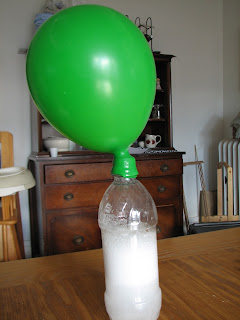This is a very simple demonstration, good for very young students who are just beginning to grasp the differences between solids, liquids and gases. It's also a fun demonstration of chemical changes for older students. I mean really, who doesn't love a good baking soda and vinegar reaction?!?
Put some baking soda into a balloon (you might want a funnel to do this). You might want to put some on a plate as well, so the students can observe it.
Pour some vinegar into a bottle. You might want to allow the students to watch you pour, so they can see how the vinegar flows and takes the shape of the bottle.
Place the balloon over the bottle, being careful not to dump the baking soda in at this point.
Lift up the balloon, so the solid pours into the liquid.
In a matter of moments, you'll have captured the third state of matter: a gas (carbon dioxide).


